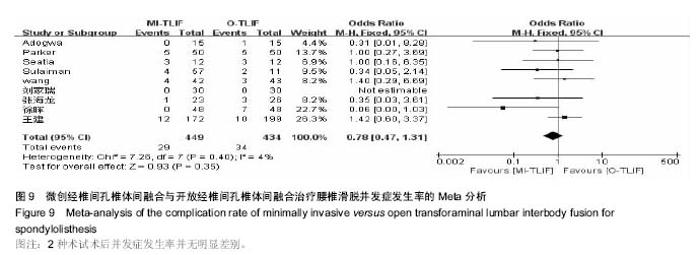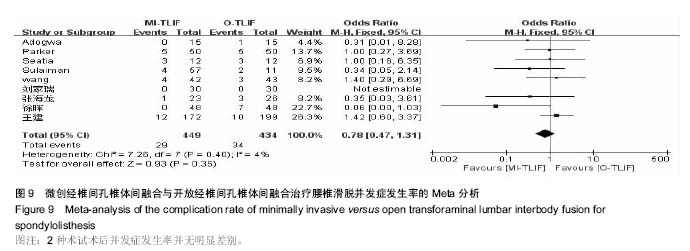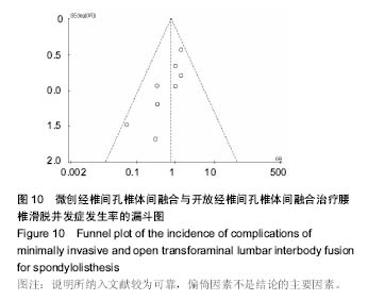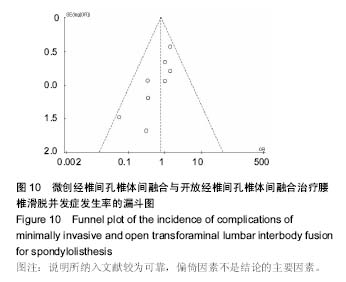Chinese Journal of Tissue Engineering Research ›› 2017, Vol. 21 ›› Issue (15): 2453-2460.doi: 10.3969/j.issn.2095-4344.2017.15.027
Minimally invasive versus open transforaminal lumbar interbody fusion for spondylolisthesis: a meta-analysis
Yan Bing-shan1, 2, Xu Bao-shan2, Liu Yue2, Yang Qiang2
- 1Graduate School of Tianjin Medical University, Tianjin 300070, China; 2Tianjin Hospital, Tianjin 300211, China
-
Online:2017-05-28Published:2017-06-07 -
Contact:Xu Bao-shan, M.D., Chief physician, Tianjin Hospital, Tianjin 300211, China -
About author:Yan Bing-shan, Studying for master’s degree, Graduate School of Tianjin Medical University, Tianjin 300070, China; Tianjin Hospital, Tianjin 300211, China -
Supported by:the National Natural Science Foundation of China, No. 81272046 and 31670983; the Research and Development Program of Health and Family Planning Commission of Tianjin City, No. 14KG121; the Natural Science Foundation of Tianjin City, No. 15JCYBJC25300
CLC Number:
Cite this article
Yan Bing-shan, Xu Bao-shan, Liu Yue, Yang Qiang. Minimally invasive versus open transforaminal lumbar interbody fusion for spondylolisthesis: a meta-analysis [J]. Chinese Journal of Tissue Engineering Research, 2017, 21(15): 2453-2460.
share this article
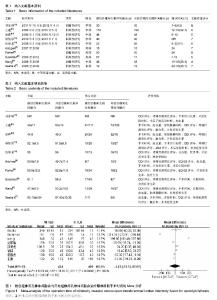
2.1 文献质量评价 按照文献检索方式及制定的纳入标准及排除标准,共计纳入研究文献10篇[5-14],回顾性队列研究7篇[5,7-8,11-14],随机对照试验3篇[6,9-10]。 共计纳入病例963例,其中男性383例,女性580例,微创经椎间孔椎间融合489例,开放经椎间孔椎体间融合474例(表2)。 2.2 微创经椎间孔椎间融合与开放经椎间孔椎体间融合治疗腰椎滑脱手术指标的评价 2.2.1 手术时间 纳入文献全部提供了手术时间的参 数[5-14],但只有8篇文献描述了手术时间的均数值和标准差[7-14],提取此8篇文献的数据进行统计分析,异质性检验I2 =100%,P=0.97,说明有明显异质性。选择随机效应模型进行统计分析,计算合并统计量,结果显示微创经椎间孔椎间融合与开放经椎间孔椎体间融合治疗腰椎滑脱手术时间差异无显著性意义(WMD=-1.43,95% CI(-83.54,80.68),P=0.97),说明2种术式治疗腰椎滑脱的手术时间无明显差别(图1)。"
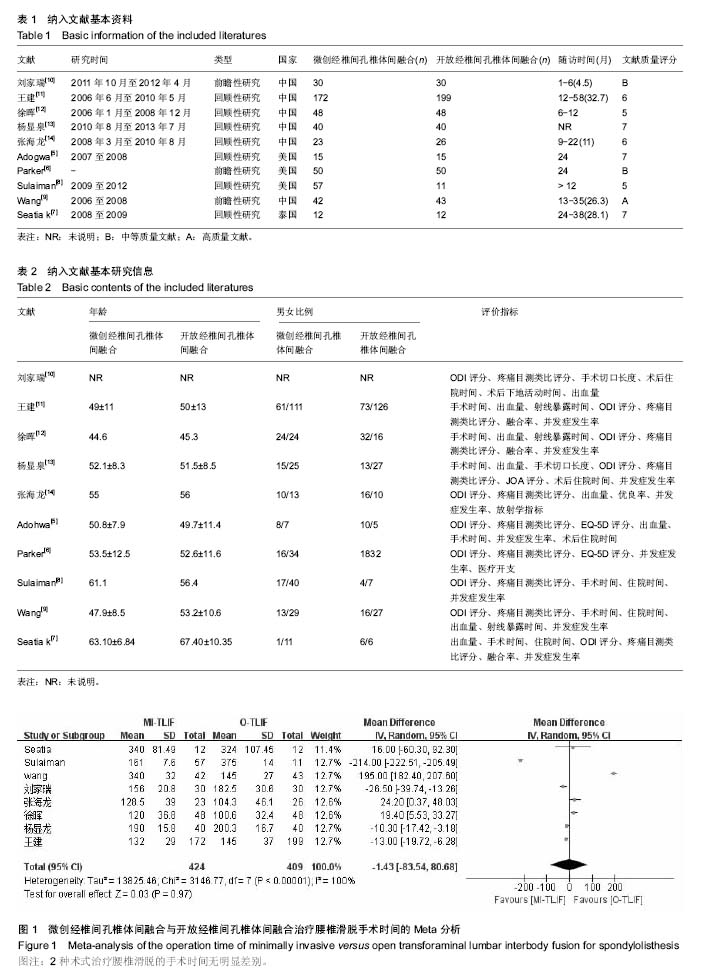
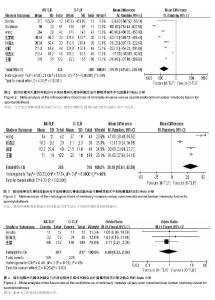
2.2.2 术中出血量 纳入文献全部提供了术中出血量的参数[5-14],但只有8篇文献描述了术中出血量的均数值和标准差[7-14],将此8篇文献的数据进行统计分析,异质性检验I2 =99%,P < 0.000 01,说明纳入文献有明显异质性。选择随机效应模型,合并统计量显示2种术式治疗腰椎滑脱术中出血量差异有显著性意义[WMD=-376.25,95% CI (-525.63,-226.88),P < 0.000 01],说明微创经椎间孔椎体间融合与开放经椎间孔椎体间融合相比,能明显减少术中出血量(图2)。 2.2.3 术中射线暴露时间 全部文献中共4篇文献描述了术中射线暴露时间的均数值和标准差[9,11-12,14],异质性检验I2 =96%,P < 0.000 01,存在明显异质性,采用随机效应模型,合并统计量结果显示2种术式治疗腰椎滑脱术中射线暴露时间差异有显著性意义[WMD=30.1,95% CI (17.61,42.59),P < 0.000 01],说明微创经椎间孔椎间融合射线暴露时间明显长于开放经椎间孔椎体间融合(图3)。 2.3 末次随访融合率 全部文献中共3篇文献描述了末次随访融合率的均数值和标准差[7, 11,14],异质性检验I2 = 0%,P=0.79,无明显异质性,采用固定效应模型,合并统计量结果显示2种术式治疗腰椎滑脱末次随访融合率差异无显著性意义[OR=0.88,95%CI(0.32,2.39),P=0.80,说明2种术式能取得相同的融合率(图4)。"
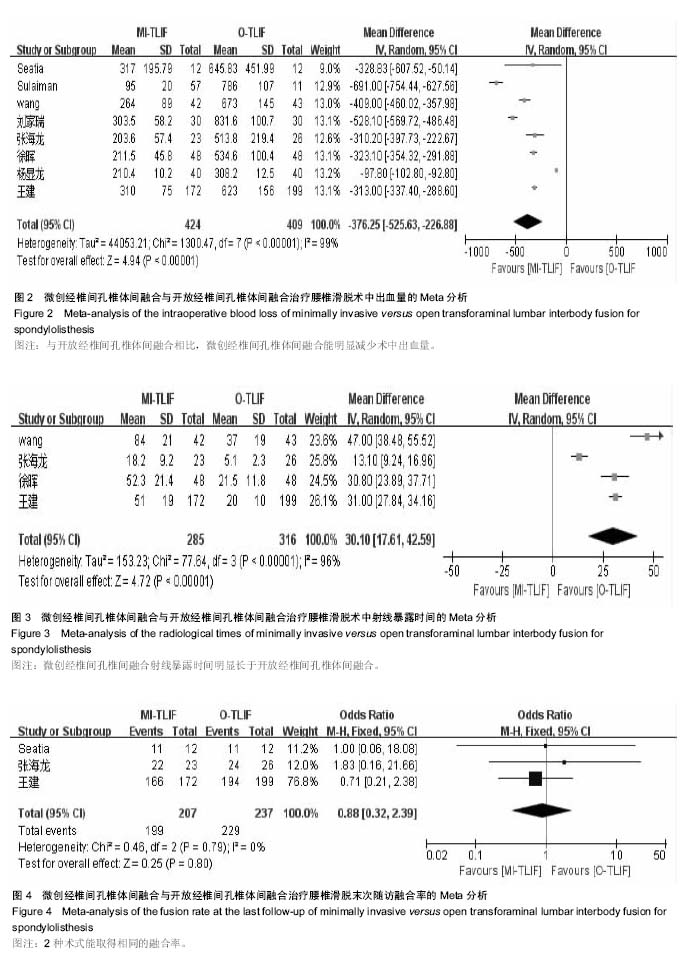

2.4 疼痛改善的评价 全部纳入文献中共8篇文献提供了2组术前及末次随访的疼痛目测类比评分[5-7,9,11-14]。开放经椎间孔椎体间融合组(图5)术前及末次随访疼痛目测类比评分差异有显著性意义[WMD=4.50, 95%CI(3.53,5.46),P < 0.000 1];微创经椎间孔椎体间融合组(图6)。术前及末次随访疼痛目测类比评分差异有显著性意义[WMD=4.78, 95%CI(3.82,5.75),P < 0.000 1]。说明2种术式均能明显缓解患者疼痛。 2.5 功能改善的评价 全部纳入文献中共8篇文献提供了微创经椎间孔椎体间融合组与开放经椎间孔椎体间融合组术前及末次随访的ODI功能障碍指数[5-7,9,11-14]。 图7显示开放经椎间孔椎体间融合组()术前及末次随访ODI指数差异有显著性意义[WMD=25.77,95%CI (20.85,30.69),P < 0.000 1]。 图8显示微创经椎间孔椎体间融合组()术前及末次随访疼痛目测类比评分差异有显著性意义[WMD=29.63 95%CI (22.29,39.96),P < 0.000 1]。 以上结果说明2种术式均能明显改善患者功能障碍。"
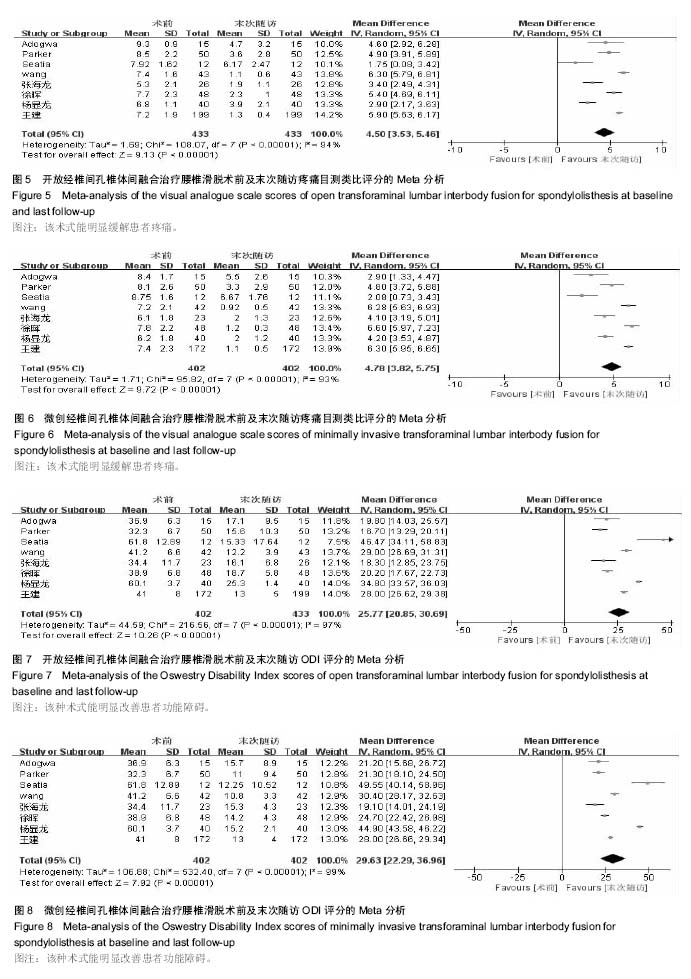
| [1] Fan SW,Zhao X.Correlative problem of lumbar instability and lumbar spondylolisthesis.Zhongguo Gu Shang.2010;23(4): 241-244.[2] Harms J,Rolinger H.A one-stager procedure in operative treatment of spondylolistheses: dorsal traction-reposition and anterior fusion (author's transl).Z Orthop Ihre Grenzgeb. 1982;120(3):343-347.[3] Foley KT,Lefkowitz M A.Advances in minimally invasive spine surgery.Clin Neurosurg.2002;49:499-517.[4] Isaacs RE,Podichetty VK,Santiago P,et al.Minimally invasive microendoscopy-assisted transforaminal lumbar interbody fusion with instrumentation.J Neurosurg Spine.2005;3(2): 98-105.[5] Adogwa O,Parker S L,Bydon A,et al.Comparative effectiveness of minimally invasive versus open transforaminal lumbar interbody fusion: 2-year assessment of narcotic use, return to work, disability, and quality of life.J Spinal Disord Tech.2011;24(8):479-484.[6] Parker S L,Adogwa O,Bydon A,et al.Cost-effectiveness of minimally invasive versus open transforaminal lumbar interbody fusion for degenerative spondylolisthesis associated low-back and leg pain over two years.World Neurosurg.2012;78(1-2):178-184.[7] Saetia K,Phankhongsab A,Kuansongtham V,et al.Comparison between minimally invasive and open transforaminal lumbar interbody fusion.J Med Assoc Thai.2013;96(1):41-46.[8] Sulaiman WA,Singh M.Minimally invasive versus open transforaminal lumbar interbody fusion for degenerative spondylolisthesis grades 1-2: patient-reported clinical outcomes and cost-utility analysis.Ochsner J.2014,14(1): 32-37.[9] Wang J,Zhou Y,Zhang Z F,et al.Comparison of one-level minimally invasive and open transforaminal lumbar interbody fusion in degenerative and isthmic spondylolisthesis grades 1 and 2.Eur Spine J.2010;19(10):1780-1784.[10] 刘家瑞,朱肖奇,程小芸,等.Quadrant减压sextant内固定治疗退变性腰椎失稳症与开放TILF临床对比分析[J].实用临床医药杂志,2012,16(13):37-40.[11] 王建,周跃,张正丰,等.微创经椎间孔腰椎体间融合术治疗腰椎滑脱症的临床研究[J].中华外科杂志,2011,49(12):1076-1080.[12] 徐晖,肖立军,陈文贵.微创经椎间孔椎体间融合术与开放手术治疗腰椎滑脱症临床分析[J].河北医学,2013,19(1):48-51.[13] 杨显泉,宋光虎.微创TLIF治疗Ⅰ或Ⅱ度单节段退行性腰椎滑脱症的效果研究[J].微创医学,2015,10(4):468-470.[14] 张海龙,顾昕,贺石生,等.微创经椎间孔椎体间融合术与开放手术治疗腰椎滑脱症的疗效比较[J].中华骨科杂志,2011,31(10): 1088-1092.[15] Tuttle J,Shakir A,Choudhri HF.Paramedian approach for transforaminal lumbar interbody fusion with unilateral pedicle screw fixation. Technical note and preliminary report on 47 cases.Neurosurg Focus.2006;20(3):E5.[16] Kawaguchi Y,Matsui H,Tsuji H.Back muscle injury after posterior lumbar spine surgery. A histologic and enzymatic analysis.Spine (Phila Pa 1976).1996;21(8):941-944.[17] Luo Z,Rao H,Huang D,et al.Comparison of minimally invasive using a tubular retraction system versus open transforaminal lumbar interbody fusion for the treatment of lumbar degenerative diseases.Zhonghua Yi Xue Za Zhi.2015; 95(33):2681-2685.[18] Phan K,Rao PJ,Kam A C,et al.Minimally invasive versus open transforaminal lumbar interbody fusion for treatment of degenerative lumbar disease: systematic review and meta-analysis.Eur Spine J.2015;24(5):1017-1030.[19] Schizas C,Tzinieris N,Tsiridis E,et al.Minimally invasive versus open transforaminal lumbar interbody fusion: evaluating initial experience.Int Orthop.2009;33(6): 1683-1688.[20] Lau D,Lee JG,Han SJ,et al.Complications and perioperative factors associated with learning the technique of minimally invasive transforaminal lumbar interbody fusion (TLIF).J Clin Neurosci.2011;18(5):624-627.[21] Majid K,Fischgrund JS.Degenerative lumbar spondylolisthesis: trends in management.J Am Acad Orthop Surg.2008;16(4):208-215. |
| [1] | Jing Jinpeng, Zhang Yue, Liu Xiaomin, Liu Yi. Traditional Chinese medicine injection for promoting blood circulation in prevention of deep vein thrombosis after orthopedic surgery: network meta-analysis [J]. Chinese Journal of Tissue Engineering Research, 2022, 26(9): 1467-1476. |
| [2] | Yao Xiaoling, Peng Jiancheng, Xu Yuerong, Yang Zhidong, Zhang Shuncong. Variable-angle zero-notch anterior interbody fusion system in the treatment of cervical spondylotic myelopathy: 30-month follow-up [J]. Chinese Journal of Tissue Engineering Research, 2022, 26(9): 1377-1382. |
| [3] | Liu Gang, Ma Chao, Wang Le, Zeng Jie, Jiao Yong, Zhao Yi, Ren Jingpei, Hu Chuanyu, Xu Lin, Mu Xiaohong. Ankle-foot orthoses improve motor function of children with cerebral palsy: a Meta-analysis based on 12 randomized controlled trials [J]. Chinese Journal of Tissue Engineering Research, 2022, 26(8): 1299-1304. |
| [4] | Wu Min, Zhang Yeting, Wang Lu, Wang Junwei, Jin Yu, Shan Jixin, Bai Bingyi, Yuan Qiongjia. Effect of concurrent training sequences on body composition and hormone response: a Meta-analysis [J]. Chinese Journal of Tissue Engineering Research, 2022, 26(8): 1305-1312. |
| [5] | Zhang Jinglin, Leng Min, Zhu Boheng, Wang Hong. Mechanism and application of stem cell-derived exosomes in promoting diabetic wound healing [J]. Chinese Journal of Tissue Engineering Research, 2022, 26(7): 1113-1118. |
| [6] | An Weizheng, He Xiao, Ren Shuai, Liu Jianyu. Potential of muscle-derived stem cells in peripheral nerve regeneration [J]. Chinese Journal of Tissue Engineering Research, 2022, 26(7): 1130-1136. |
| [7] | Li Jian, Bao Zhengqi, Zhou Pinghui, Zhu Ruizhi, Li Zhixiang, Wang Jinzi. Effects of posterior single open-door laminoplasty and anterior cervical corpectomy fusion on cervical sagittal balance parameters in the treatment of multilevel cervical spondylotic myelopathy [J]. Chinese Journal of Tissue Engineering Research, 2022, 26(6): 949-953. |
| [8] | Yang Jun, Yang Qun, Zhang Rui, Jiang Chang. A novel slidable pedicle screw-rod system for lumbar tuberculosis: promoting bone graft fusion by producing stress stimulation to fused segment [J]. Chinese Journal of Tissue Engineering Research, 2022, 26(6): 914-918. |
| [9] | Liu Yiyi, Qiu Junqiang, Yi Longyan, Zhou Cailiang. Effect of resistance training on interleukin-6 and C-reactive protein in middle-age and elderly people: a Meta-analysis [J]. Chinese Journal of Tissue Engineering Research, 2022, 26(5): 804-812. |
| [10] | Wang Nan, Qian Yuzhang, Xie Lin. Network Meta-analysis of different acupuncture methods for the treatment of lumbar disc herniation [J]. Chinese Journal of Tissue Engineering Research, 2022, 26(5): 813-820. |
| [11] | Chen Xiaoxu, Luo Yaxin, Bi Haoran, Yang Kun. Preparation and application of acellular scaffold in tissue engineering and regenerative medicine [J]. Chinese Journal of Tissue Engineering Research, 2022, 26(4): 591-596. |
| [12] | Kang Kunlong, Wang Xintao. Research hotspot of biological scaffold materials promoting osteogenic differentiation of bone marrow mesenchymal stem cells [J]. Chinese Journal of Tissue Engineering Research, 2022, 26(4): 597-603. |
| [13] | Shen Jiahua, Fu Yong. Application of graphene-based nanomaterials in stem cells [J]. Chinese Journal of Tissue Engineering Research, 2022, 26(4): 604-609. |
| [14] | Zhang Tong, Cai Jinchi, Yuan Zhifa, Zhao Haiyan, Han Xingwen, Wang Wenji. Hyaluronic acid-based composite hydrogel in cartilage injury caused by osteoarthritis: application and mechanism [J]. Chinese Journal of Tissue Engineering Research, 2022, 26(4): 617-625. |
| [15] | Li Hui, Chen Lianglong. Application and characteristics of bone graft materials in the treatment of spinal tuberculosis [J]. Chinese Journal of Tissue Engineering Research, 2022, 26(4): 626-630. |
| Viewed | ||||||
|
Full text |
|
|||||
|
Abstract |
|
|||||
